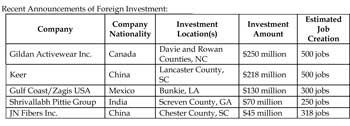WASHINGTON, D.C. —March 5, 2014 — The U.S. textile industry has seen a surge in foreign direct investment over the past 8 months. No less than 8 foreign companies have made public announcements over that period to invest more than $700 million in new U.S. textile facilities and equipment. These investments are projected to provide approximately 1,900 new jobs in North Carolina, South Carolina, Georgia, and Louisiana.
The United States has become an increasingly attractive option for textile manufacturers looking for competitive energy, transportation, and fiber costs. Beyond these basic economic factors, a key driver for this recent investment surge has been the success of U.S. trade policy in the textile sector. Over the past 25 years, the U.S. has completed a series of free trade agreements that include a Yarn-Forward Rule of Origin for textile and apparel products. As the name implies, the Yarn-Forward rule requires that yarn, fabric, and assembly production steps be completed in the FTA region in order to qualify for duty-free preference into the United States. This rule has served as a catalyst for record breaking exports of U.S. yarns and fabrics that are eventually processed into finished apparel and textile home furnishings in FTA partner countries. These goods are then shipped back to the U.S. duty free for purchase by U.S. consumers.
The Yarn-Forward rule has helped the U.S. textile industry become the third largest exporter of textile products in the world. U.S. exports of all textile products were nearly $17.9 billion in 2013. Over the past 10 years, U.S. textile exports have grown dramatically, from $12.7 billion in 2003 to $17.9 billion in 2013, a 40.6% increase over that period.
The single largest investment announcement, approximately one-quarter of a billion dollars, came from Gildan Activewear Inc., based in Montreal, Canada. Peter Iliopoulos, Senior Vice-President of Public and Corporate Affairs at Gildan highlights the benefit of a strong Yarn-Forward rule for American textiles stating “The Yarn-Forward rule was a significant factor in Gildan’s decision, announced in September of 2013, to make an additional investment of approximately $250 million in U.S. yarn spinning operations. We have designed our supply chain in order to most effectively leverage preferential treatment under U.S. trade agreements. Consequently, we want to ensure that our products are always eligible for such preferential treatment.”
This investment of approximately $250 million will be made by Gildan over its 2014 and 2015 fiscal years in order to build two new yarn spinning facilities in North Carolina, one in Salisbury and another one in Mocksville. Each one is expected to be over 500,000-square-feet in size. The venture is slated to create approximately 500 new jobs in Davie and Rowan Counties, NC.
In addition to Gildan’s announcement, the U.S. textile sector continues to see a positive trend in foreign direct investment. Since August of 2013, textile companies from India, Mexico, and China
have announced new investment plans in the United States. These projects will generate a
projected 1,368 new U.S. jobs beyond the 500 associated with Gildan’s investment.
“This massive investment surge and the creation of approximately 1,900 much needed
manufacturing jobs is a concrete example of how Yarn-Forward has made a major contribution
to the U.S. economy and workforce. You need look no further for how sound provisions in trade
agreements can make a real difference in our economy,” stated Augustine Tantillo, President and
CEO of the National Council of Textile Organizations.
Key Facts about the U.S. Textile Industry
- The U.S. textile industry is a large manufacturing employer in the United States. The overall textile sector – from textile fibers to apparel – employed nearly 499,000 workers in 2013.
- Textile companies alone employed 231,000 workers.
- The U.S. government estimates that one textile job in this country supports three other jobs.
- U.S. textile shipments totaled more than $56.6 billion in 2013.
- The U.S. textile industry is the third largest exporter of textile products in the world. Exports of all textile products were nearly $17.9 billion 2013. Total textile and apparel exports were a record $23.7 billion in 2013.
- Nearly two-thirds of U.S. textile exports during 2013 went to our Western Hemisphere free trade partners. The U.S. textile industry exported to more than 170 countries, with 23 countries buying more than $100 million a year.
- The U.S. textile industry supplies more than 8,000 different textile products per year to the U.S. military.
- The U.S. is the world leader in textile research and development, with private textile companies and universities developing new textile materials such as conductive fabric with antistatic properties, electronic textiles that monitor heart rate and other vital signs, antimicrobial fibers, antiballistic body armor for people and the machines that carry them and new garments that adapt to the climate to make the wearer warmer or cooler.
- The U.S. textile industry invested $17.7 billion in new plants and equipment from 2001 to 2011. And recently producers have opened new fiber, yarn and recycling facilities to convert textile waste to new textile uses and resins.
- The U.S. textile industry has increased productivity by 24 percent over the last 10 years, making textiles one of the top industries among all industrial sectors in productivity increases.
- In 2013, textile workers on average earned 145% more than apparel store workers ($577 per week vs. $235) and received health care and pension benefits.
Posted March 6, 2014
Source: NCTO





